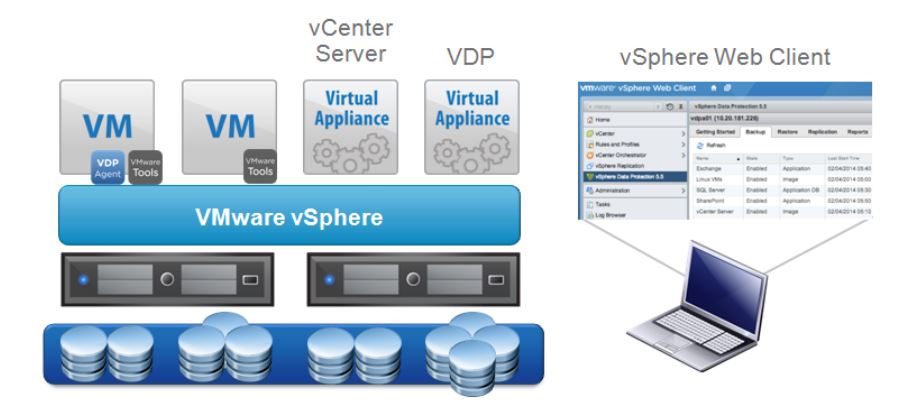I am now in final legs of my VCAP6-Deploy exam prepration and objective 7.2 revolves all around VDP. Since I have no prior experience with VDP, this is the best time for me to explore this product.
I have broken down this series in various part so that the posts do not get too lengthy and this is the first part where we will be discussing about what VDP is and what it offers when it comes to backing up and recovering vSphere deployments.
What is vSphere Data Protection (VDP)?
vSphere Data Protection is a backup and recovery solution designed for vSphere environments which is powered by EMC Avamar. It provides agentless, image-level virtual-machine backups to disk. It also provides application-aware protection for business-critical Microsoft applications (such as Exchange, SQL Server and SharePoint) along with WAN-efficient, encrypted backup data replication.
Capabilities of vSphere Data Protection
The key capabilities of VDP are (not limited to):
- Agent-less virtual machine backup and restore that reduces complexity and deployment time
- Integration with EMC Data Domain for additional scale, efficiency, and reliability
- Flexibility to restore replicated backup data at both the source and target locations
- Automated backup verification that provides the highest level of confidence in backup data integrity
- Appliance and backup data protection via a checkpoint-and-rollback mechanism
- File Level Restore (FLR), which enables granular file and folder restoration without the need for an agent in Microsoft Windows and Linux virtual machines
- Significantly reduced backup data disk space requirements using Avamar variable-length deduplication technology
- VDP make use of vSphere Storage APIs and Changed Block Tracking (CBT) technique to reduce load on the vSphere host infrastructure and minimize backup window requirements
- Reliable, efficient replication of backup data between vSphere Data Protection appliances for redundancy and offsite data protection
Consult this whitepaper by VMware to know more about these capabilities in greater details and also what other capabilities lies within VDP.
vSphere Data Protection Architecture
VDP is deployed as a prebuilt, Linux-based virtual appliance and can be deployed to any storage supported by vSphere e.g. VMFS, NFS, and vSAN datastores. All tasks related to backup and restore is performed via VDP plugin which is integrated in vSphere Web Client.

One VDP Appliance supports up to 400 Virtual Machines and a maximum of 20 appliances can be deployed per vCenter Server. Each appliance is deployed by default with four vCPUs and 4 gigs of memory.
Optionally, as many as eight external proxies (virtual appliances) can be deployed per VDP appliance. Proxies can be deployed to enable SCSI HotAdd transport backups of virtual machines running on datastores not directly accessible by the vSphere Data Protection virtual appliance.
For application backups using VDP, you need to download application agents via vSphere Web Client and install them in the Guest OS of the virtual machines that are running Exchange Server, SQL Server, and SharePoint etc.
VDP External Proxy
VDP by default has one internal proxy that can run upto max 8 concurrent backups and restores.
We can also deploy upto 8 external proxies/VDP appliance. An external proxy is a light-weight appliance which offers following benefits:
- Run more concurrent backups with external proxies.
- Perform hot-add backups where VDP appliance do not have access to the protected VMs storage.
- Can be used for VM’s with FLR on EXT4 based file systems.
Important: Once an external proxy is configured, the internal proxy is automatically disabled
Deployment Options
There are various deployment options available with VDP and it can be deployed with the following configurations:
- 0.5 TB backup datastore, 873 GB disk space, 4 vCPU, 4 GB memory.
- 1 TB backup datastore, 1600 GB disk space, 4 vCPU, 4 GB memory.
- 2 TB backup datastore, 3 TB disk space, 4 vCPU, 4 GB memory.
- 4 TB backup datastore, 6 TB disk space, 4 vCPU, 8 GB memory.
- 6 TB backup datastore, 9 TB disk space, 4 vCPU, 10 GB memory.
- 8 TB backup datastore, 12 TB disk space, 4 vCPU, 12 GB memory.
Thats it for this post. In next post of this series we will look at installation and configuration of VDP appliance.
Useful Links
I hope you find this post informational. Feel free to share this on social media if it is worth sharing. Be sociable 🙂
